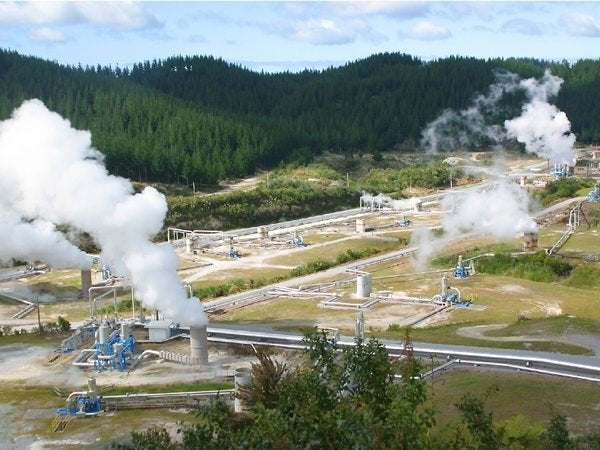
Maybe you've been hearing more about geothermal energy lately -- it gets mentioned more in the mix with solar and wind these days, especially when politicians are listing off, quickly as possible, all the forms of renewable energies they can think of. In case you don't know much about it, HuffPost Green has compiled this little FAQ.
What is geothermal energy?
Geothermal energy is a cheap and largely untapped natural energy resource. It's an intriguing sustainable energy source due to its unlimited supply, 24-hour availability and ability to decrease reliance on fossil fuels.
The EPA defines geothermal for us:
Geothermal energy is produced from the constant temperature of the earth. This can be accessed by drilling into the earth and extracting that heat and turning it into usable energy. Geothermal energy is an enormous underused resource that provides clean renewable energy in virtually unlimited supplies.
Blogger Michelle Bennett of CleanTechnica praises geothermal energy's non-stop energy supply:
The potential return could be as enormous as the forces of nature at work: clean, green, unlimited energy for the rest of this geologic era. Unlike solar and wind, geothermal generates a steady supply of energy 24 hours a day, everyday. Anything so abundant and predictable won't go untapped for long.
What http://www.clean-energy-ideas.com/articles/what_is_geothermal_energy.html>geothermal energy is, can essentially be described with the sentence; heat contained and produced by the heating of the earth in two different ways. The more powerful geothermal energy comes from deep within the earth, where the temperature is hot enough to melt the surrounding rocks. The second source of geothermal energy is as a results of the suns rays beating down on the land surface. We shall now look into these two main sources.
How Does It Work?
One of the methods to generate electricity from http://www.buzzle.com/articles/how-does-geothermal-energy-work.html> geothermal energy is by pumping hot water into sedimentary hotspots. The steam generated by this method is used to produce electricity. The condensed steam is again circulated into the permeable sedimentary stream of a hotspot.
Another method is by using volcanic magma. The temperature of partially molten magma is approximately 650 degree Celsius. This heat is used to boil water to generate electricity.
Some geothermal plants also use the hardened magma that is extremely hot. This system uses hot dry rock. Pipes are looped through these hot dry rocks through which water is circulated. The heat of the rocks converts the water into steam prior to transferring the heat to a steam generator.
How Much Energy Could Be Generated?
Google will invest $10 million to the development of enhanced geothermal systems (EGS). According to Treehugger, it takes just 2% of the heat present beneath North American soil to fulfill the United States' energy needs. Last week, scientists asserted that just 1% of Australia's geothermal energy potential is enough to power the nation for 26,000 years. This change in Australia's energy source will help to drastically reduce worldwide carbon emissions.
Currently Australia generates about 77% of its electricity from coal and is the world's largest per-capita carbon emitter, with individual emissions being five times those of China.
Where Is It Currently In Use?
Geothermal energy is currently used in homes throughout Europe and is most popular in Iceland, Sweden, Norway and increasingly in the United Kingdom. In June, Germany instituted a tariff to build up its geothermal electricity use. By 2015, the German government hopes to run hundreds of geothermal power plants.
An increasing amount of organizations are utilizing geothermal energy such as the Oregon Institute of Technology, which is the first university to be fully sustained by geothermal power.
But if you're a politician and want a chance to list off as many renewable energy types as possible, check out the new visitor center at the Queens Botanical Garden: \
It's considered the greenest public building in New York City due to its advanced green construction and energy-saving technology. The NRDC hails the building as the "model of efficiency."
It gets 17% of its energy from rooftop solar panels, it heats its water using geothermal power and has an 8,000 square foot green roof that is performing beyond expectations. According to Jennifer Souder, the Garden's Director of Capital Projects, preliminary tests from last summer measured the building's green roof temperature at 82 degrees, while nearby white and black tar roofs were cooking at 115 and 170 degrees respectively. Expect significant energy savings and a reduction in the "urban heat island" effect to result from this facility.
Related:
::Consider if geothermal heat pumps are right for your home from the Huffington Post
::Read about the US Department of Energy's Decision To Invest $90 Million In Advanced Geothermal Research on the Huffington Post
::More at the Huffington Post Green Energy big news page